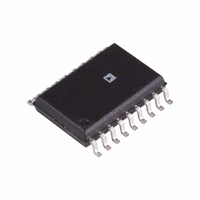ADG467BR-REEL7 Analog Devices Inc, ADG467BR-REEL7 Datasheet - Page 11

ADG467BR-REEL7
Manufacturer Part Number
ADG467BR-REEL7
Description
IC OCTAL PROTECTOR 18SOIC
Manufacturer
Analog Devices Inc
Series
ADG467r
Specifications of ADG467BR-REEL7
Rohs Status
RoHS non-compliant
Voltage - Clamping
±40V
Technology
Mixed Technology
Number Of Circuits
8
Applications
General Purpose
Package / Case
18-SOIC (7.5mm Width)
Operating Temperature (min)
-40C
Operating Temperature (max)
85C
Operating Temperature Classification
Industrial
Mounting
Surface Mount
Package Type
SOIC W
Power (watts)
-
Voltage - Working
-
Lead Free Status / RoHS Status
Not Compliant
TRENCH ISOLATION
The MOS devices that make up the channel protector are
isolated from each other by an oxide layer (trench) (see Figure 26).
When the NMOS and PMOS devices are not electrically
isolated from each other, parasitic junctions between CMOS
transistors may cause latch-up. Latch-up is caused when P-N
junctions that are normally reverse biased become forward
biased, causing large currents to flow, which can be destructive.
R
E
N
C
H
T
V
P
N
Sx
+
–
P-CHANNEL
V
G
Figure 26. Trench Isolation
SUBSTRATE (BACKGATE)
BURIED OXIDE LAYER
V
Rev. B | Page 11 of 16
P
Dx
+
R
E
N
C
H
T
V
N
P
CMOS devices are normally isolated from each other by
junction isolation. In junction isolation, the N and P wells of the
CMOS transistors form a diode that is reverse biased under
normal operation. However, during overvoltage conditions, this
diode becomes forward biased. A silicon-controlled rectifier
(SCR) type circuit is formed by the two transistors causing a
significant amplification of the current that, in turn, leads to
latch-up. With trench isolation, this diode is removed; the result
is a latch-up-proof circuit.
Sx
–
+
N-CHANNEL
V
G
V
N
Dx
+
R
N
C
H
T
E
ADG467












